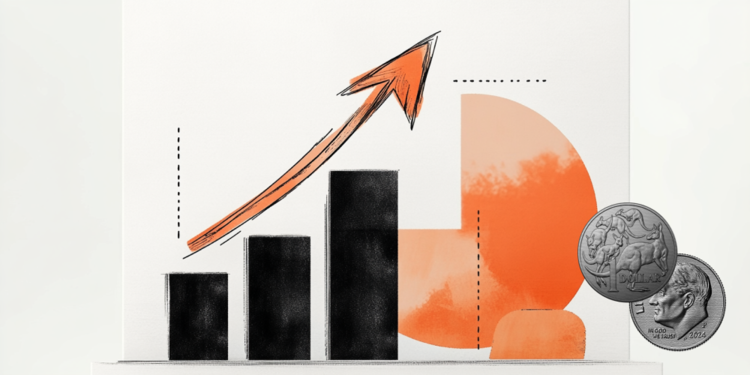- AUD/USD gains sharply to near 0.6050 despite worsening trade relations between the US and China.
- In retaliation to Trump’s reciprocal tariffs, China has imposed a 34% import duty on goods coming from the US.
- Fed Powell expects that risks to inflation and unemployment have skewed on the upside by Trump’s tariffs.
The AUD/USD pair soars to near 0.6050 during European trading hours on Tuesday. The Aussie pair strengthens as the Australian Dollar (AUD) advances strongly even though fears of a trade war between the United States (US) and China have escalated.
Australian Dollar PRICE Today
The table below shows the percentage change of Australian Dollar (AUD) against listed major currencies today. Australian Dollar was the strongest against the US Dollar.
| USD | EUR | GBP | JPY | CAD | AUD | NZD | CHF | |
|---|---|---|---|---|---|---|---|---|
| USD | -0.18% | -0.17% | -0.63% | -0.36% | -0.94% | -0.98% | -0.56% | |
| EUR | 0.18% | -0.04% | -0.50% | -0.19% | -0.76% | -0.76% | -0.39% | |
| GBP | 0.17% | 0.04% | -0.43% | -0.13% | -0.71% | -0.72% | -0.28% | |
| JPY | 0.63% | 0.50% | 0.43% | 0.26% | -0.31% | -0.38% | 0.11% | |
| CAD | 0.36% | 0.19% | 0.13% | -0.26% | -0.59% | -0.60% | -0.13% | |
| AUD | 0.94% | 0.76% | 0.71% | 0.31% | 0.59% | -0.00% | 0.44% | |
| NZD | 0.98% | 0.76% | 0.72% | 0.38% | 0.60% | 0.00% | 0.45% | |
| CHF | 0.56% | 0.39% | 0.28% | -0.11% | 0.13% | -0.44% | -0.45% |
The heat map shows percentage changes of major currencies against each other. The base currency is picked from the left column, while the quote currency is picked from the top row. For example, if you pick the Australian Dollar from the left column and move along the horizontal line to the US Dollar, the percentage change displayed in the box will represent AUD (base)/USD (quote).
China vows to retaliate against the US in the face of worse-than-expected tariffs imposed by President Donald Trump. Earlier in the day, a spokesperson for the Chinese Ministry of Commerce warned that the US president’s new tariff threats were “a mistake on top of a mistake” and China will “fight to the end” to protect its interest.
The comments came from Beijing after Trump threatened on Monday to slap additional 50% import duty on China for announcing 34% levy on the US as a countermeasure against reciprocal tariffs revealed on Liberation Day.
An absence of demand for goods by the US from China will also stem a sharp decline in the business activity in Australia, given its significant dependency on its exports to China.
In addition to US-China trade tensions, bloating Reserve Bank of Australia (RBA) dovish bets are also unfavorable for the Australian Dollar. RBA dovish bets have swelled as tariffs on China are also a big hit on the Australian economy.
Meanwhile, the US Dollar (USD) remains under pressure as investors expect that Trump’s tariff agenda could lead to a resurgence in inflation and slower economic growth in the US economy. We face a highly uncertain outlook with elevated risks of both higher unemployment and higher inflation,” Federal Reserve (Fed) Chair Jerome Powell said on Friday.
US-China Trade War FAQs
Generally speaking, a trade war is an economic conflict between two or more countries due to extreme protectionism on one end. It implies the creation of trade barriers, such as tariffs, which result in counter-barriers, escalating import costs, and hence the cost of living.
An economic conflict between the United States (US) and China began early in 2018, when President Donald Trump set trade barriers on China, claiming unfair commercial practices and intellectual property theft from the Asian giant. China took retaliatory action, imposing tariffs on multiple US goods, such as automobiles and soybeans. Tensions escalated until the two countries signed the US-China Phase One trade deal in January 2020. The agreement required structural reforms and other changes to China’s economic and trade regime and pretended to restore stability and trust between the two nations. However, the Coronavirus pandemic took the focus out of the conflict. Yet, it is worth mentioning that President Joe Biden, who took office after Trump, kept tariffs in place and even added some additional levies.
The return of Donald Trump to the White House as the 47th US President has sparked a fresh wave of tensions between the two countries. During the 2024 election campaign, Trump pledged to impose 60% tariffs on China once he returned to office, which he did on January 20, 2025. With Trump back, the US-China trade war is meant to resume where it was left, with tit-for-tat policies affecting the global economic landscape amid disruptions in global supply chains, resulting in a reduction in spending, particularly investment, and directly feeding into the Consumer Price Index inflation.

